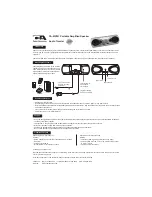
GP 2500A
Operation
19
2.3
Generator Derating
All generators are subject to derating for altitude and temperature.
Internal combustion engines, unless modified, run less efficiently at
higher altitudes due to the reduction of air pressure. This translates
into a lack of power and thus reduction in generator output.
Temperature affects both engine and generator performance. As
temperature increases, an engine will run less efficiently and more
resistance will be found in electrical components. Therefore, as the
temperature increases, the output of the generator decreases. Altitude
also affects the cooling capacity of air—the higher the altitude the less
dense the air is and thus the lower its ability to transfer heat.
For every increase in altitude of 500 m (1650 ft.) above 1000 m (3300
ft.), the output of the generator will be reduced by 3%. For every
increase of 5° C (9° F) in ambient temperature above 40° C (104° F),
the output of the generator will be reduced by 3%. Use the tables
shown for altitude and temperature deration factors. It may be
necessary to consider both altitude and ambient temperature deration
factors to determine true generator output.
Ambient Temp.
°C (°F)
Derate
Factor
45 (113)
3 %
0.97
50 (122)
6 %
0.94
55 (131)
9 %
0.91
60 (140)
12 %
0.88
Altitude
m (ft.)
Derate
Factor
1500 (4900)
3 %
0.97
2000 (6600)
6 %
0.94
2500 (8200)
9 %
0.91
3000 (9900)
12 %
0.88
3500 (11500)
15 %
0.85
4000 (13100)
18 %
0.82
















































